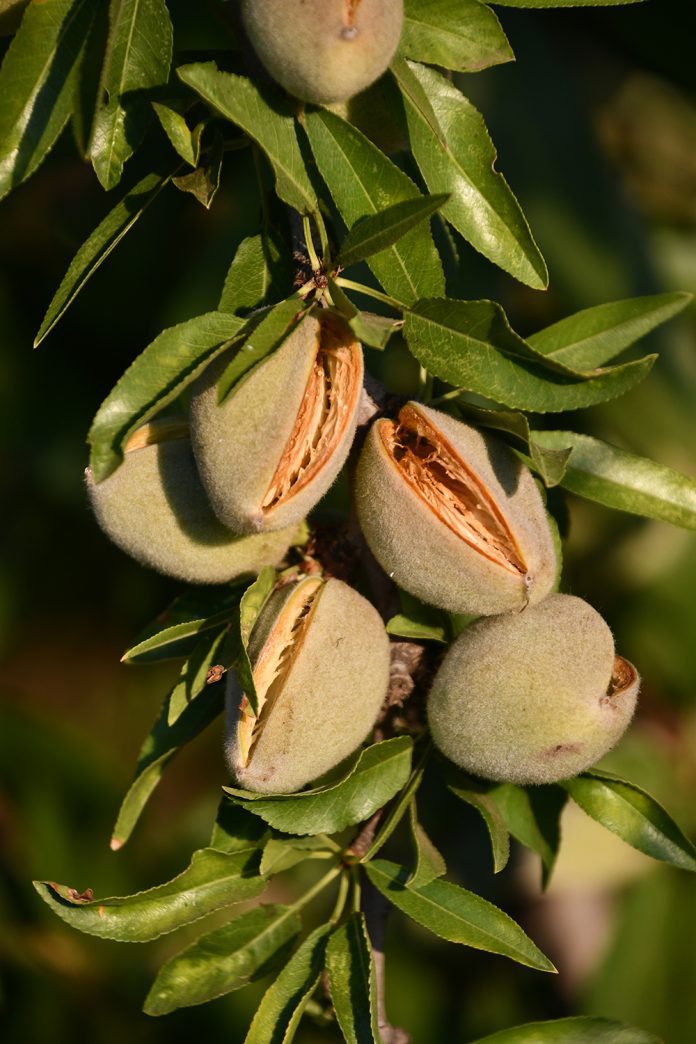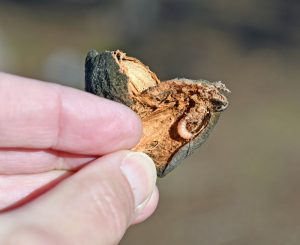
A complete picture of this year’s almond harvest in the Sacramento and San Joaquin Valleys is still weeks away, but some crop quality trends are becoming notable.
Damage to the almond crop from navel orangeworm and stink bug feeding varies greatly from region to region and variety to variety, but the Sacramento Valley almond crop was hit hard, Mel Machado, grower relations for Blue Diamond, said.
USDA-ARS Entomology Researcher Joel Siegel noted that crop damage was not severe across all growing regions. There may be a number of factors at play, including management.
“A lot of the damage is a reflection of management decisions that are price-driven. The challenge is going to be allocating dollars for sanitation in a year where the crop is disappointing,” Siegel added.
Siegel, who is based in Parlier, is coordinating a USDA-funded five-year areawide program to control navel orangeworm (NOW) in almonds, pistachios and walnuts.
Pollinizers Get Hit
Machado emphasized in early October that final tallies on crop damage would not be realized until all nuts have been processed.
He said in many cases the NOW flight did not coincide with hull split in Nonpareil and damage was less. That was not the case with pollinizer varieties.
“The next flight got the pollinizers at hull split,” Machado said. Damage levels are variable between areas, and it will be weeks until the damage picture is clear, he added.
Machado attributed some of the higher damage levels to the lack of insecticide treatments at hull split in the pollinizer varieties.
“It is possible growers opted not to spray even if they expected problems due to the cost,” Machado said.
Management factors in the Sacramento Valley were likely contributors to the NOW damage in almonds this year, Siegel said. Growers who haven’t been adversely affected by high NOW pressure in past years will have to understand that two hull split sprays may be needed to control NOW in their orchards. Two sprays, Siegel said, would give them more leeway, particularly if the timing of the early NOW flights was missed.
They need to recognize NOW will be a problem and they will get hit,” Siegel said. Spraying every row is critical to control.
“If they just spray every other row, they are asking for it,” Siegel said.
Growers who lost production due to the spring freeze may have less incentive to protect their crop.
“It is hard to justify a spray application for a 200-pound crop,” Siegel said.
Protecting Crop Quality
Growers in the southern San Joaquin Valley have much more experience with NOW damage, Siegel said. They know skipping every other row or relying on just one hull split spray can result in higher reject percentages. This year, he said they were likely directing their input costs to protect their Nonpareil quality, not the pollinizers.
Almond growers in the southern San Joaquin know they will experience NOW if they don’t make appropriate treatments, but costs were likely a challenge this year.
It will be painful, Siegel said, but growers will have to bite the bullet and spend the money for orchard sanitation this winter to lower NOW populations.
According to Sudan Gyawaly, Sacramento Valley UCCE IPM advisor, and Luke Milliron, UCCE orchard systems advisor in Butte, Glenn and Tehama counties, NOW pressure in the Sacramento Valley was high. Their interviews with PCAs found the damage was attributed to cutting costs in management with insecticide applications.
Gyawaly and Milliron reported they were told by PCAs that NOW damage percentage in some blocks was in the double digits. Monitored orchards showed that NOW peak flights were earlier than previous years by a week to 10 days, resulting in hull split nuts exposed to female NOW for more than two weeks.
They concluded that compromised sanitation due to poor pricing led to a higher NOW population going into bloom. A reduced crop due to freeze coupled with reduced control efforts and low nut numbers resulted in higher infestation rates and more pressure over larger areas.
Navel orangeworm damage in almond orchards varies due to level of pressure in the orchard, orchard sanitation practices and harvest timing among other things. The UC IPM Guidelines note that some almond cultivars are more susceptible to damage, especially later-maturing softshell almonds with a lengthy hull split period or poor shell seal.
High levels of NOW pose an increased risk to an almond crop because the worms bore into the nut and feed on the kernel. Not only is the nut damaged, but the feeding opens the door to Aspergillus molds, which can produce aflatoxins, a contaminant that can cause rejection in export and domestic markets.

Stink Bug Pressure
Machado said it appears the stink bugs are responsible for significant almond damage in a number of orchards again this year. This plant bug has been found in orchards for years, but not in high numbers, according to the UC IPM Guidelines. One theory that has been put forth is that reduced use of broad-spectrum insecticides may be allowing the stink bug population to increase to a level where feeding is causing noticeable damage.
Stink bug feeding causes brown spot, a mark and depression on the kernel. Machado said that damage by late stink bug feeding has increased in recent years. Plant bugs include leaffooted plant bug and several stink bug species.
Nuts damaged by stink bug feeding will exude gummy material from the puncture site. Kernels of damaged nuts either become wrinkled and misshapen, or if already hardened before bug damage, will contain a black spot at the puncture site.
Gyawaly and Milliron said plant bug damage to almonds in the Sacramento Valley in the 2022 growing season was mild to average. There were cases of elevated damage in the 8% to 10% range compared to less than 1% in previous years. They attributed the rise in numbers to management costs.
Machado’s key message to almond growers is to determine exactly what is causing the damage in individual blocks. With that information, an appropriate pest control plan can be developed.

Cecilia Parsons | Associate Editor
Cecilia Parsons has lived in the Central Valley community of Ducor since 1976, covering agriculture for numerous agricultural publications over the years. She has found and nurtured many wonderful and helpful contacts in the ag community, including the UCCE advisors, allowing for news coverage that focuses on the basics of food production.
She is always on the search for new ag topics that can help growers and processors in the San Joaquin Valley improve their bottom line.
In her free time, Cecilia rides her horse, Holly in ranch versatility shows and raises registered Shetland sheep which she exhibits at county and state fairs during the summer.















